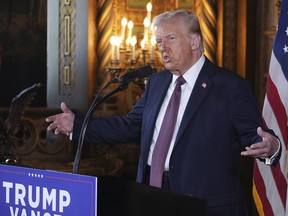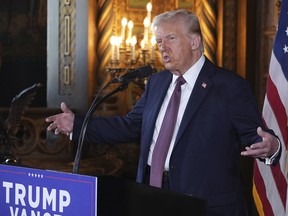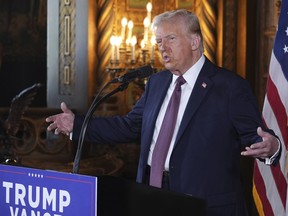Trump’s provocative vow to reshape North America by economic means has reignited a deep debate about the future of Canada–United States relations. At a late-2024 press event hosted at his Mar-a-Lago resort in Florida, the president-elect signaled a hard-edged stance on Canada and Mexico, promising to deploy “substantial” tariffs on goods from both neighbors. He framed the approach as a form of economic leverage, explicitly rejecting the idea of military annexation while asserting that removing the border’s artificially drawn line would yield tangible national-security and economic benefits. In his words, the United States would apply economic pressure to alter the continental balance of power, while arguing that the U.S. has long shielded Canada in ways that justify a reevaluation of their bilateral relationship. This assertion of strategic reorientation has triggered a swift, multi-layered response across political, economic, and social arenas in North America.
From the outset, the remarks crystallized a central tension: the proposition of redefining a neighbor’s sovereignty through tariff policy rather than diplomacy. Trump described the potential path as an “economic force” rather than a military endeavor, insisting that such a move would effectively redefine national borders by financial means. He suggested that Canada—an economically integrated partner with a long-standing, complex trade relationship with the United States—could become something akin to a U.S. state, provided that bilateral trade terms and strategic calculations were recalibrated. The rhetorical and strategic implications of this framing were immediate. In addition to economic tariffs, the president-elect asserted that the United States subsidizes Canada heavily, quantifying that support at roughly $200 billion per year—a claim that, while provocative, underscored the broader narrative he was advancing about subsidies, deficits, and competitive disparities.
The data points cited in this context were designed to magnify a broader concern about the trade deficit and the structure of energy trade, rather than to present a precise accounting. The U.S. trade deficit with Canada for goods and services in 2023 stood at about $40.6 billion, according to the U.S. Census Bureau. Within that framework, energy exports—most notably Canadian crude oil—emerged as a pivotal axis. The United States has been a major buyer of Canadian energy, importing a substantial daily volume that, in some periods, exceeded four million barrels per day. These energy dynamics have long anchored bilateral economic interdependence, producing a steady stream of benefits that Trump’s tariff plan would threaten to disrupt. The juxtaposition of a large, integrated energy market with a nascent tariff threat adds a layer of complexity to any assessment of immediate policy outcomes.
Beyond the tariff rhetoric, the policy trajectory Trump outlined touched on broader questions about national security, economic strategy, and regional cohesion. The idea of erasing the border’s “artificially drawn line”—a metaphor for deep economic integration—appears to flirt with a more radical rethinking of North American governance. Even as the president-elect insisted that military action would not be the tool employed to pursue annexation, he framed economic force as a superior instrument. The underlying calculation is not simply about tariffs; it encompasses the perceived value of North American self-sufficiency in critical sectors and the strategic leverage that comes with a more constrained, protectionist trade regime. This framing has sparked immediate concerns among policymakers, business leaders, and analysts about the stability of cross-border supply chains, the reliability of energy flows, and the consequences for international investment.
In the ensuing political and economic discourse, observers highlighted the tension between rhetoric and practical policy. Tariffs at a 25 percent level or higher on Canadian and Mexican goods—if implemented unilaterally—could reverberate through manufacturing sectors that depend on a highly integrated continental supply chain. It is not only about immediate price increases for consumers or changes in import costs; it is about reconfiguring production strategies, relocation of facilities, and potential shifts in procurement patterns. A tariff regime would incentivize firms to reassess sourcing options, weigh the viability of reshoring certain activities, and evaluate the risk of retaliation that could intensify in other sectors, including agriculture, automotive, and energy. The debate also touches on the broader question of how a more protectionist stance would affect negotiations surrounding other elements of the USMCA framework, as well as the durability of long-standing alliances and economic commitments in North America.
Another critical thread in Trump’s remarks centers on perceptions of subsidy and competitive fairness. He argued that the United States bears responsibilities for subsidizing Canadian production and using that subsidy to the detriment of American industry, a claim that would require rigorous economic scrutiny if translated into policy. While the number cited—a hypothetical $200 billion—serves as a rhetorical device to emphasize the perceived imbalance, the broader point is anchored in a familiar political debate: how to manage subsidies and structural advantages within a deeply integrated, bilateral marketplace. The presence of this argument underscores the risk that tariff-reliant strategies could provoke retaliatory measures that would compound challenges for industries reliant on cross-border trade. It also highlights the potential implications for energy markets, where Canada’s status as a pivotal supplier to the U.S. creates a dependency dynamic that policymakers would need to manage carefully.
In this initial framing of the issue, the Trump administration signaled a willingness to pursue a new strategic path—one that prioritizes national sovereignty and economic leverage over conventional, rules-based trade diplomacy. The pragmatic question is how such a shift would play out in practice: what tariffs would be imposed, how would they be calibrated against a broad range of goods and services, what safeguards might be introduced to protect domestic industries, and how would the United States address the potential for a broader trade conflict? The conversation also involves the risk of undermining confidence in cross-border investment and the stability of long-term commercial commitments that have supported growth, job creation, and regional development on both sides of the border for decades.
The immediate response from Canadian officials and political leaders reflected a mixture of caution, skepticism, and resolve. The government and opposition alike acknowledged the extraordinary gravity of the proposals, while emphasizing that Canada would not be deterred from defending its interests or from continuing to engage with its most important trading partner through lawful, constructive channels. The public mood among Canadians, as reflected in public surveys, indicated a broad opposition to the notion of Canada becoming a U.S. state, underscoring how deeply the idea resonates in a country that prizes its sovereignty and a balanced approach to governance. This response is not merely a reflex; it is grounded in a political culture that values national autonomy, a robust rule of law, and an economy that has benefited immensely from the stability provided by predictable and rules-based trade relationships.
As the policy discourse evolves, observers have noted that the electoral calendar and domestic political dynamics in both countries will shape the trajectory of any such proposals. In Canada, for instance, long-running questions about leadership, party strategies, and public sentiment contribute to a climate in which bold, destabilizing proposals are met with a blend of caution and strategic resistance. In the United States, the domestic political environment—where economic messaging and protectionist sentiment often resonate with voters facing a rising cost of living and job insecurity—could heighten pressure on the administration to pursue a harder line in trade negotiations. The interplay between executive rhetoric, legislative feasibility, and practical economic consequences will determine whether these ideas translate into concrete policy steps, or instead remain a high-stakes rhetorical provocation designed to recalibrate the political landscape ahead of elections and budget cycles.
Overall, Trump’s remarks at Mar-a-Lago have reintroduced a provocative, high-stakes narrative into the conversation about North American integration. The notion of using “economic force” to alter the geopolitical and economic order invites a thorough, methodical analysis of potential consequences for trade, energy security, currency markets, investment decisions, and political alliances. The coming weeks and months are likely to feature intensified debate about the feasibility of tariffs, the resilience of the U.S.–Canada energy relationship, and the long-term implications for regional cooperation. As policymakers scrutinize these proposals, the central question remains: can North America sustain a stable, mutually beneficial partnership in an era of rising protectionism, while preserving the shared interests that have underpinned one of the world’s most integrated corridors of trade and industry?
Canada’s energy and trade architecture sits at the heart of this debate, and any potential policy shift would immediately implicate a range of strategic sectors and macroeconomic indicators. The United States’ dependence on Canadian energy, particularly crude oil, has long been a defining feature of their bilateral economy. In parallel, Canada’s role as a key supplier of agricultural inputs and raw materials—such as uranium and potash—adds layers of strategic importance to bilateral policy decisions. The possible introduction of export taxes by Canada in response to U.S. tariff threats—on commodities including uranium, oil, and potash—reflects a broader willingness to leverage secondary instruments in a trade conflict. This would be a significant development, signaling a move toward policy tools that many countries reserve for truly emergent geopolitical contests, rather than routine trade friction. The potential for such measures underscores how interwoven the economies are and how quickly a tariff-based strategy could escalate into broader regulatory and fiscal measures across multiple sectors.
In the wake of these discussions, the currency markets have already begun to react. The Canadian dollar experienced declines against the U.S. dollar in the wake of Trump’s tariffs talk, with traders monitoring the trajectory of the loonie and assessing the implications for competitiveness, import costs, and inflation. A weaker Canadian currency could have mixed consequences: it could improve the price competitiveness of Canadian exports in some markets while increasing the cost of imported goods and materials for Canadian businesses, thereby affecting domestic consumers and firms that rely on imported inputs. Currency movements in response to heightened tariff rhetoric often reflect a confluence of expectations about policy direction, investor confidence, and the broader global economic environment. In this case, the shifts underscore how quickly macroeconomic indicators can move in response to political signals, even before formal policy measures are enacted.
In Canada, Prime Minister Justin Trudeau’s public stance—emphasizing commitment to the country’s sovereignty and its willingness to withstand and respond to threats—has framed the issue within a broader conversation about national resilience and strategic autonomy. A notable element has been a robust social media response from Trudeau and his cabinet, reiterating Canada’s resolve and signaling that there will be no accommodation of efforts to erode national self-determination. The political calculus surrounding Trudeau’s leadership, including his resignation, contributes to a broader discursive environment in which leadership transitions are assessed in the context of economic risk, public opinion, and the ability to navigate a complex international landscape. The resignation announcement, itself framed within a governance struggle over party alignment and electoral prospects, adds a layer of political uncertainty that could influence how seriously Canada treats U.S. policy pressures in any future negotiations.
Public sentiment in Canada appears to tilt decisively against the notion of joining the United States as a state. A recent poll indicated that more than eight in ten Canadians oppose the idea, reinforcing the sense that Canadian sovereignty remains a foundational national priority. For a government that must balance economic interests with political legitimacy, the challenge lies in articulating a pathway that protects Canada’s key economic ties while preserving its autonomy and governance framework. In this context, the role of the opposition and potential future leaders becomes particularly salient. Conservative Party Leader Pierre Poilievre, seen by many polls as a likely contender for the next general election, has consistently asserted that Canada would never become a U.S. state, signaling strong continuity in the political messaging even amid extraordinary diplomatic stress. His stance helps frame the public conversation around who would steer Canada through what could be a tumultuous realignment of continental trade and security policy.
The policy searchlight then shifts toward strategic economic responses to any tariff threats. Ottawa’s officials have explored the possibility of deploying export taxes on critical commodities—uranium, oil, and potash among them—if a broader trade war materializes. This approach would represent a measured, but potentially provocative, method of safeguarding national economic interests while signaling resilience to external pressure. The dialogue around export taxes would need to be carefully calibrated to avoid unnecessary escalation, maintain the credibility of Canada’s trading partners, and minimize the risk of triggering retaliatory policies that could impact Canada’s own industries. The balancing act would involve weighing the value of preserving robust export revenue streams against the potential costs of reduced access to critical markets. It would also require close coordination with allied partners to mitigate potential spillover effects into other sectors, including energy, manufacturing, and agriculture.
In addition to macroeconomic and political considerations, there are important sector-specific implications to track. Canada is the single largest external source of oil for the United States, a relationship that underpins both countries’ energy security and industrial activity. Canada’s uranium exports are the most significant foreign source of fuel for U.S. nuclear power plants, and its potash plays a crucial role as a fertilizer for American agriculture. Any policy shift affecting Canada’s ability to supply these commodities would reverberate through energy markets, electricity generation, agricultural output, and food prices. The interconnectedness of energy, mining, and agricultural supply chains means that even modest policy shifts could trigger disproportionate market responses, from price volatility to investment realignments and longer-term technology and infrastructure decisions. The currency dynamics discussed earlier would further compound these effects, influencing pricing, competitiveness, and risk assessments across multiple sectors.
As the Trump discourse continues to unfold, market participants, policymakers, and business leaders will be watching closely for the exact policy instruments, timelines, and enforcement mechanisms that could accompany any tariff regime or export tax policy. The risk is not solely about the tariff rate on a particular category of goods; rather, it is about the overall architecture of bilateral trade, the resilience of North American value chains, and the long-term strategic posture toward cooperation in a rapidly changing global economy. The stakes extend beyond the immediate economic calculus to questions about sovereignty, national identity, and the role of regional alliances in a world where economic power is increasingly wielded as a tool of national strategy. This broader frame will shape how the U.S. and Canada navigate the next phase of their relationship, with potential consequences for the broader regional and global economy.
Conclusion
The remarks delivered at Mar-a-Lago and the ensuing political reactions have thrust the Canada–United States relationship into a moment of consequential uncertainty. The concept of using “economic force” to pursue a redefined continental order raises fundamental questions about sovereignty, strategic interests, and the durability of long-standing trade ties. While Trump’s rhetoric centered on tariffs, subsidies, and border redefinition, the reality of translating such ideas into policy would involve a roiling mix of legislative feasibility, domestic political support, regulatory mechanisms, and international retaliation risks. The U.S. trade deficit with Canada in 2023, the scale of Canadian energy exports to the United States, and Canada’s role as a principal supplier of uranium and potash all underscore how deeply interwoven the two economies are. Any policy move that disrupts this integration would ripple across markets, prices, investment, and cross-border mobility, affecting workers, businesses, and households on both sides of the border.
Canada’s response—anchored in sovereignty, a commitment to democratic norms, and a readiness to deploy countermeasures if necessary—points to a deliberate, cautious path forward. The political dynamics in Canada, including Trudeau’s leadership transition and the elevation of potential successors who emphasize national autonomy, add another layer of complexity to policy calculations. Public sentiment, which appears broadly opposed to any notion of accession to the United States, reinforces the imperative for a diplomacy-first approach that respects national integrity while exploring constructive, rules-based avenues for cooperation. The implications for energy markets, currency movements, and broader economic strategy will depend on the precise mix of actions, negotiations, and assurances that accompany any future policy framework. As the United States contemplates a more protectionist posture, both nations must contend with the realities of deep economic interdependence, the risks of escalation, and the opportunity to reaffirm a shared commitment to stability, prosperity, and mutual security in a rapidly evolving global landscape. The path forward will require careful calibration, sustained dialogue, and a focus on policy instruments that preserve the benefits of integration while safeguarding each country’s core interests.
In short, the Trump administration’s commentary has reactivated a high-stakes conversation about the future of North American trade, energy security, and political sovereignty. The stakes are high not only for the two countries involved but for the broader regional economy that depends on a predictable, transparent framework for cross-border cooperation. As policymakers deliberate, business leaders chart contingency plans, and the public weighs competing visions for the continent’s future, one overarching truth remains clear: the relationship between Canada and the United States is deeply entrenched, economically significant, and politically sensitive. Any movement toward a radically altered arrangement would demand a level of strategic foresight, negotiated restraint, and multilateral coordination that goes beyond unilateral policy shifts. The coming period will reveal whether this moment of heated rhetoric evolves into a pragmatic, durable settlement that preserves shared prosperity while respecting sovereignty and democratic norms.




